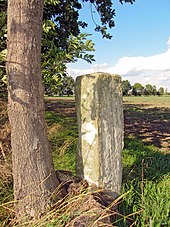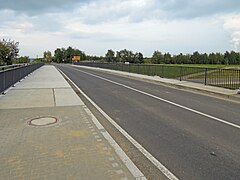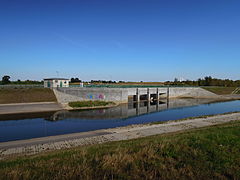Zitzschen
|
Zitzschen
City of Zwenkau
Coordinates: 51 ° 13 ′ 13 ″ N , 12 ° 16 ′ 1 ″ E
|
|
|---|---|
| Height : | 126 m |
| Residents : | 446 (Dec. 31, 2014) |
| Incorporation : | April 1, 1973 |
| Incorporated into: | Grossdalzig |
| Postal code : | 04442 |
| Area code : | 034203 |
|
Zitzschen from a bird's eye view from the north
|
|
Zitzschen is a district of the city of Zwenkau in the Leipzig district in Saxony . Before it came to Zwenkau in 1993, it had belonged to the municipality of Großdalzig since April 1, 1973 .
location
Zitzschen is about four kilometers west of Zwenkau city center. The federal highway 186 Zwenkau – Schkeuditz and the White Elster run east of the village , accompanied by the Elster cycle path . About 500 meters northeast of the outskirts of Zitzschen is the west bank of Lake Zwenkau .
The surrounding towns are Zwenkau, Kleindalzig , Großdalzig , Scheidens, Löben, Kitzen , Kleinschkorlopp and Knautnaundorf in the east, starting clockwise .
The next stop on the Leipzig-Gera rail link is about two kilometers south of Zitzschen in Großdalzig. The Leipzig-Südwest driveway of the A 38 motorway can be reached after about six kilometers via the B 186.
history
According to archaeological finds, the area around Zitzschen is a very old settlement area. The beginning of a continuous settlement could be proven for the time about 7000 years ago.
The center of Zitzschen is of Slavic origin. The Slavs settled in the form of a round , which had its only entrance from the east. From the village square in Zitzschen there are a few dead ends that lead to further outlying farms and enlarge the space.
Zitzschen experienced a first expansion in the course of the German eastward expansion in the form of a part of the street, today's Thomas-Müntzer-Straße. The first documented mention of the place name Zitzschen was made in 1213 in a deed of donation from Burgrave Gerhard von Leisnig , in which Albertus de Zizzcin is mentioned as a witness . In the Middle Ages , Zitzschen was shaped by the diocese of Merseburg , both ecclesiastically and secularly dependent. There were numerous leanings on Zitzschener Flur by the bishops of Merseburg. In the 15th century, the lords of Fichtenberg were enfeoffed with the Zitzschen manor.
After the Reformation , Zitzschen belonged to the Pegau Inspectorate in 1560 and was therefore ecclesiastically subordinate to the Leipzig Consistory , while the state administration was with the Lützen office until the beginning of the 19th century . As a result of the Congress of Vienna in 1815 Zitzschen came in 1816 with the western part of the Office Lutzen to Merseburg in the administrative district of Merseburg and thus to the Prussian province of Saxony . Boundary stones from this period between the Kingdom of Prussia and the Kingdom of Saxony are still preserved.
On April 18, 1945, American tank units, coming from Kitzen, moved into Zitzschen and were relieved by the Red Army in July . The neighboring manor Mausitz was dissolved as a result of the land reform and set up in fields bordering on Zitzschen for Zitzschen gardens and new farmer sites. For the latter, new farmer houses were built on Kitzner Strasse.
From 1950 Zitzschen belonged to the Weißenfels district in the state of Saxony-Anhalt founded in 1947 . With the formation of the districts in the GDR in 1952, Zitzschen and some neighboring towns became the district of Leipzig and therefore now belongs to this after the formation of the Free State of Saxony .
In 1952 the collectivization of agriculture also reached Kitzen; three farms merged to form LPG type I. In 1960 a type III LPG was created, which later became the type I LPG. In 1972 Zitzschen was incorporated into Großdalzig and in 1993 with this to Zwenkau.
Comprehensive village renovation measures were carried out in 2002–2005 after Zitzschen became a Saxon model village in 1996 and a Saxon sponsorship village in 2001.
In 2014, Zitzschen took part in the competition “ Our village has a future ”, took 1st place in the district qualification and qualified for the 2015 state competition, where 3rd place was achieved.
The church
The earliest evidence of a Zitzschen church comes from the year 1428. However, this was not yet in its current location, but more decentralized in the old cemetery on Schkorlopper Weg. Little is known about their appearance. Church bills show the presence of a clock, an organ and three bells. Towards the end of the 18th century, the church showed major structural damage, so that a new building had to be considered in connection with the expansion that was also necessary due to the growth of the community.
On April 16, 1792, the demolition of the old church began and on May 14, 1792 the foundation stone for the new one was laid in the current central square. The plans came from the Dresden architect Christian Friedrich Schuricht . The builders came from the local area. The altar and columns were made by a sculptor Völler from Bohemia . The organ with 25 registers on two manuals and the pedal was made by the Trampeli brothers' workshop from Adorf / Vogtl. built. The three new bells came from the Ulrich foundry in Laucha an der Unstrut . The approximately 30 meters long and 12 meters wide church with two galleries was consecrated on November 1, 1796.
In 1832 the tower had to be restored due to the weather, and the baroque hood was given the closed slate roofing typical of Zitzschen . On the occasion of the 100th anniversary, the church was extensively renovated in 1894, received new oak stalls, a church heating system and was magnificently painted by the painter Zander-Holle, including the triumphant Christ on the ceiling.
This condition was restored during the renovations in 2007 and 2011 after the organ had been restored from 1990 to 1994 by the organ builder Georg Wünning from Großolbersdorf . It is one of the largest and largely original works by the Trampeli brothers. The organ and church are on Saxony's list of monuments.
- The organ disposition
|
|
|
||||||||||||||||||||||||||||||||||||||||||||||||||||||||||||||||||||||||||||||||||||||||||||||||||||||||||||||||||||||||
- Coupling : manual slide coupling, pedal coupling
- Secondary register: tremulant to the main work, beating to the upper work
Zitzschen and the White Elster
Until 1977 Zitzschen was three kilometers away from the White Elster. Because of the fact that in the 1970s the open-cast lignite mine in Zwenkau swung westward north of Zwenkau , the railway line and the White Elster had to be relocated to the west and the B186 rebuilt. Between 1972 and 1977 the new river bed was built between Kleindalzig and Hartmannsdorf , which now runs directly past Zitzschen. Because of the way the river bed was built, this section of the White Elster is also called the “concrete elster”. A bridge leads from the B 186 to Zitzschen, which was renewed between 2012 and 2014.
After the closure of the Zwenkau opencast mine in 1999, the flooding of the remaining hole to Lake Zwenkau began, using not only local groundwater but also swamp water from open-cast mines that were still active. In 2010, the construction of an inlet structure was started on the White Elster near Zitzschen , through which water can be channeled from the river to the lake. It is used to flood the lake, but also to drain it into the lake during floods. After its completion in May 2013, it experienced its flood test in the flood at the beginning of June 2013 , when 130 m³ of water per second flowed into the lake and Leipzig was protected from the threat of flooding.
Opposite the Zitzschener bridge there is a popular vantage point on Lake Zwenkau with information about the former Zwenkau opencast mine and access to the circular route around the lake.
literature
- Daniel Kalis (Ed.): Zitzschen - History & Memories . Festschrift for the 800th anniversary of the first mention, Zitzschen 2013, ISBN 978-3-9811228-3-1
Web links
- www.zitzschen.de ( Memento from June 29, 2017 in the Internet Archive )
- Zitzschen on Lake Zwenkau
- Zitzschen in the Digital Historical Directory of Saxony
Individual evidence
- ↑ Armin Rudolph in Zitzschen - history & memories , p. 13
- ↑ Markus Cottin in Zitzschen - History & Memories , p. 22
- ^ Zitzschen - History & Memories , p. 8
- ↑ Markus Cottin in Zitzschen - History & Memories , p. 34
- ^ Karlheinz Blaschke , Uwe Ulrich Jäschke : Kursächsischer Ämteratlas , Leipzig 2009, ISBN 978-3-937386-14-0 , p. 84 f.
- ^ The district of Merseburg in the municipal directory 1900
- ^ Zitzschen - History & Memories , pp. 11/12
- ↑ (Article by the State of Saxony on the competition)
- ↑ Markus Cottin, Daniel Kalis in Zitzschen - History & Memories , pp. 60–71
- ^ Organ building Wünning
- ^ The Trampeli organ ( Memento from February 11, 2015 in the Internet Archive ) near Leipziger Neuseenland
- ↑ LVZ online , accessed on February 10, 2015
- ↑ leipzigseen.de , accessed on February 11, 2015











